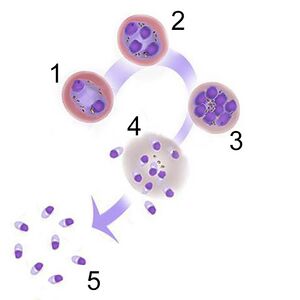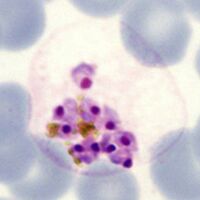Biology of the schizont: Difference between revisions
From haematologyetc.co.uk
No edit summary |
No edit summary |
||
| (2 intermediate revisions by the same user not shown) | |||
| Line 30: | Line 30: | ||
{| class="wikitable" style="border-style: none; border-width: 2px; border-color: gainsboro; color:black" | {| class="wikitable" style="border-style: none; border-width: 2px; border-color: gainsboro; color:black" | ||
|colspan="1" style = "font-size:100%; color:black; background: gainsboro |'''Morphological features and relevance'''|} | |colspan="1" style = "font-size:100%; color:black; background: gainsboro|'''Morphological features and relevance''' | ||
|} | |||
| Line 41: | Line 42: | ||
</gallery> | </gallery> | ||
<span style="font-size:10%"</span> The progressive maturation of this parasite stage means that they have a wide range of morphological forms. However, these can be readily recognised on blood films by reference to their biology [ [[Images of schizont morphology|See clinical images illustrating schizont development]] ] | <span style="font-size:10%"></span> The progressive maturation of this parasite stage means that they have a wide range of morphological forms. However, these can be readily recognised on blood films by reference to their biology | ||
[ [[Images of schizont morphology|See clinical images illustrating schizont development]] ] | |||
---- | ---- | ||
Latest revision as of 18:02, 6 November 2024
Navigation
>Main Malaria Index
>>Malaria Biology Index
>>>Current page: Schizont Biology
Biology of the Schizont
|
The stage begins with the first cycle of asexual replication forming a recognisable “schizont” then concludes when the individual “merozoites” are released to infect new erythrocytes.
The progressive maturation of this parasite stage means that they have a wide range of morphological forms. However, these can be readily recognised on blood films by reference to their biology [ See clinical images illustrating schizont development ]
|

